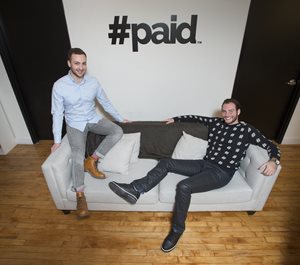Influencer Marketing Platform #paid Uses More Than Just AI
Human influence has been the heartbeat of marketing since the ‘Ad Men’ of Madison Avenue brought  finesse and creativity to commerce, inciting what is known as the creative revolution in advertising. Fast forward to modern day, where the magazines and billboards of the ‘Mad Men’ era have been replaced with digital media pouring out of screens as small as a deck of cards and as grand as the city blocks that make up Times Square. But even though the methods (and medium) of advertising have changed, the conversation brands are having with consumers remains hinged on leveraging human nature to command purchase behavior.
finesse and creativity to commerce, inciting what is known as the creative revolution in advertising. Fast forward to modern day, where the magazines and billboards of the ‘Mad Men’ era have been replaced with digital media pouring out of screens as small as a deck of cards and as grand as the city blocks that make up Times Square. But even though the methods (and medium) of advertising have changed, the conversation brands are having with consumers remains hinged on leveraging human nature to command purchase behavior.
Today, an ever-growing piece of the advertising pie is going towards Influencer Marketing, but brands are still wading into it with questions of value and true revenue potential. Steve Rubel explains this new era very well by saying “First, there's been an inversion of influence. The traditional pyramid, where authority figures on top sway the masses, has been upended. Studies show influence has shifted away from institutions and it now travels primarily through peer individuals. Second, attention has flipped as well. It's no longer optimal for brands to just demand it. Attention now must also be earned. It's about relationships over reach. Finally, content is no longer king, distribution is. Platforms are more powerful than publishers.”
Upended so perfectly describes this notion as it does challenge a ‘tired and true’ (not a typo) way of thinking but while the criticisms aren’t unfounded, Adam Rivietz, the CEO of the platform #paid, has created a way to take almost every question of influencer marketing and provide an answer backed by technology and business intelligence. Here we discuss how they allow many Fortune 1000 brands to effectively launch and run influencer campaigns through the use of both artificial and genuine intelligence, also known as the intersection of technology and the human touch.
Why Use Influencers?
One of the greatest benefits is the swing back to great ideas and beautiful, impactful, well thought out content now winning the arms race of engagement. This is one of the reasons why, as Adam said in a separate interview, influencers have grown to the popularity we are seeing today: “Influencers are content creators first. That’s why they’ve risen to the top of social media,” says Rivietz, “because they create this incredible content that actually resonates with an audience and that arguably speaks to a brand’s target audience better than the brand knows how to speak to them.”
In a nutshell, with social media as such a massive force, brands are now outsourcing their conversation to those with more social influence than the brands themselves could take the time to create, and with good reason because as Adam said, influencers are successful because they have worked to develop a loyal, engaged, highly personal connection with their audience through the masterful curation of written and visual content. It’s at the heart of their value proposition and the trend of outsourced content will only increase. In fact in 2017, the IDC predicted that “by 2020, more than 50% of a company’s commercial content will be created outside of marketing’s direct control”.
This control however, is something #paid gives back to both the brands and the content creators. In our interview Adam goes in depth describing the ways in which they address these concerns.
Bringing Intelligence Together
It is well known that the kryptonite to engagement is inauthenticity, and thanks to years of effective marketing messages, consumers’ expectations are going up and up as to what is believable from a brand. One of the missteps previously taken in the influencer marketing strategy that perhaps set an unfortunate tone early on, were brands incorrectly choosing influencers, influencers promoting products outside of their scope of interests and authenticity was then lost on both fronts.
This is one of the areas where #paid brings together the inherent strengths of artificial and genuine  intelligence: “The second part of the technology is our matching algorithm, every campaign starts with a brief, an RFP per say from a client, we upload that brief to our platform and behind this brief template is what we love to call the campaign wizard. Behind this campaign wizard actually sits our matching algorithm so in real time it analyses the exact criteria that a brand or our sales team has input into the platform and will automatically in real time filter through our roster of 15,000 influencers in over 100 countries and short list a top 100 that match the criteria that was in the brief. Then the human element kicks back in, that shortlist of 100 is then sent to our creator relations team. They are the ones that vet and onboard all of our influencers and they are actually all influencers themselves as well so then they take this list of 100 and curate that to the top 20 or 30."
intelligence: “The second part of the technology is our matching algorithm, every campaign starts with a brief, an RFP per say from a client, we upload that brief to our platform and behind this brief template is what we love to call the campaign wizard. Behind this campaign wizard actually sits our matching algorithm so in real time it analyses the exact criteria that a brand or our sales team has input into the platform and will automatically in real time filter through our roster of 15,000 influencers in over 100 countries and short list a top 100 that match the criteria that was in the brief. Then the human element kicks back in, that shortlist of 100 is then sent to our creator relations team. They are the ones that vet and onboard all of our influencers and they are actually all influencers themselves as well so then they take this list of 100 and curate that to the top 20 or 30."
I imagine one of the scariest things for brands, is the very concept of outsourcing the conversation they have with their current and prospective customers to someone else no matter the effect they have on their followers, especially considering trust can be lost in the blink of an eye (or in those light speed internet minutes following content deployed with an error in context or placement). To alleviate this, #paid offers a calming level of control: “It’s actually our goal to make this as seamless and as close to a set it and forget it experience for our clients, we want it to be very turnkey. We know from executing campaigns for the last four years that it is very cumbersome and especially if you don’t have technology you have to keep track of all your influencers… the final touch point that they have is approving all the content, every photo, every video, every caption is shared with our clients before any post actually goes live, any content is sent back to the client.”
This also underpins why, as Adam emphatically states, the human touch should never leave the influencer process: “What we like to say is as much as we are a technology first company and trying to automate this process to its fullest potential, my personal belief is that influencer marketing will never be completely automated because unlike programmatic advertising you are not just putting a photo on website you actually have to interact with humans throughout the process, they have to be available, they shoot the content, they have to be ready to post it and that there is always going to be this human element to influencer marketing, the whole value of it in the first place, so yes it’s not send and forget, I think we have gotten it to the closest point possible.”
MY POV
In my conversations with people about artificial intelligence, I encounter all levels of wariness, acceptance and excitement but my belief in it is always hinged on the same premise, it can take over the tasks the human mind doesn’t need to do, and complete them in an alarmingly quicker and more accurate way than the human mind can, freeing us up to spend more time on what we’re better at. For example, working off of intuition, knowing the unexplainable variables and utilizing them based on gut instinct. In one of my favorite books on the human experience, “Blink: The Power of Thinking Without Thinking”, famed author Malcolm Gladwell captions the idea as: "’Thin-slicing’, refers to the ability of our unconscious to find patterns in situations and behavior based on very narrow slices of experience. It is part of what makes the unconscious so dazzling.”
This is why in the exciting times we are experiencing in technology and artificial intelligence, genuine intelligence should never be taken out of the equation. Its worth in connecting with consumers is far too valuable, and is one of the many things that takes content to the point of truly standing out in a world of a million messages a minute. The conversation I mentioned in the beginning, the one brands have been having with consumers since the dawn of advertising, remains hinged on leveraging human nature to command purchase behavior and now we are just doing it through the peer influence of social media celebrities.
Here, #paid is straddling the line of utilizing both kinds of intelligence in the ways each are most valuable, taking us back to true creativity in brand strategy, addressing what could be the picking apart the threads of engagement, and bringing it to the platforms of modern day marketing through the people who have the attention of the consumer market.

Laura Myers
A digital business, marketing and social media enthusiast, Laura thrives on asking unique, insightful questions to ignite conversation. At an event or remotely, she enjoys any opportunity to connect with like-minded people in the industry.